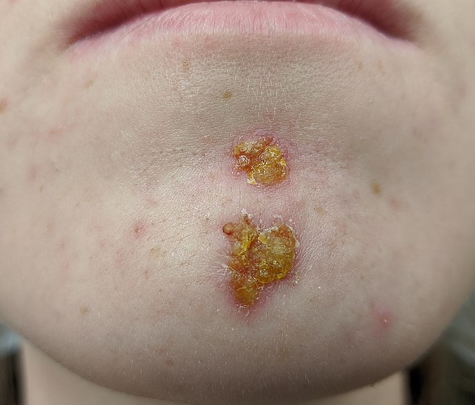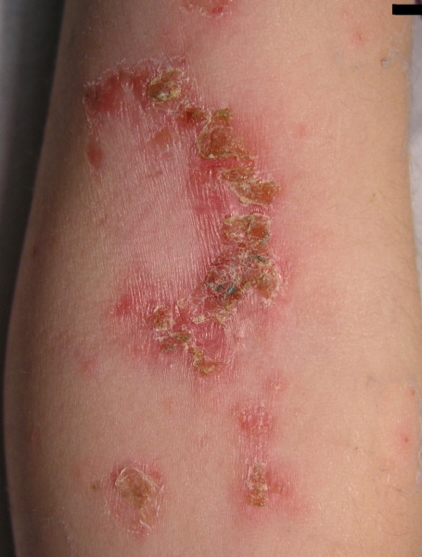Table of Contents
Overview – Impetigo
Impetigo is a highly contagious superficial bacterial skin infection, predominantly affecting young children. It is frequently seen in school-aged populations and is easily transmitted through direct skin contact or shared items. While usually self-limiting, appropriate treatment is important to prevent spread and complications such as post-streptococcal glomerulonephritis. This topic is highly relevant for final-year medical students in paediatrics, dermatology, and general practice rotations.
Definition
Impetigo is a superficial, contagious bacterial skin infection that presents as vesicles, pustules, and honey-coloured crusts.
Aetiology
- Bacterial origin:
- Staphylococcus aureus (most common)
- Streptococcus pyogenes (especially in non-bullous and ulcerative forms)
- Predisposing factors:
- Poor hygiene
- Crowded living conditions
- Skin trauma (e.g., insect bites, eczema)
Epidemiology
- Most common in preschool and primary school-aged children
- Endemic in warm, humid climates
- Outbreaks often occur in settings with close contact (e.g. schools, daycares)
- High burden in Aboriginal and Torres Strait Islander communities
Pathophysiology
- Colonisation or invasion of epidermis by S. aureus or S. pyogenes
- Disruption of the skin barrier (e.g., scratching, eczema) facilitates entry
- Inflammatory response results in vesicles/pustules → rupture → crust formation
- S. pyogenes infections may trigger immune complications (e.g. acute glomerulonephritis)
Clinical Features
1. Non-Bullous (Crusted) Impetigo
- Most common form
- Begins as small red papules or vesicles → rapidly rupture
- Honey-yellow crusts on an erythematous base
- Often on the face, around nose and mouth
- Pruritic, but not painful
- Caused by S. aureus or S. pyogenes


2. Evanherk at Dutch Wikipedia, CC BY-SA 3.0 <http://creativecommons.org/licenses/by-sa/3.0/>, via Wikimedia Commons
2. Bullous Impetigo
- Always caused by S. aureus (produces exfoliative toxin)
- Flaccid, fluid-filled bullae (larger than vesicles)
- Rupture leaves shallow erosions with thin brown crust
- Less common, but more common in neonates
3. Ulcerative (Ecthyma)
- Always caused by S. pyogenes
- Deeper infection with punched-out ulcers covered by crust
- More common in tropical climates and remote communities
Diagnosis
- Clinical diagnosis is usually sufficient
- Swabs for bacterial culture if:
- Recurrent or resistant cases
- Concern for MRSA
- Widespread infection
- Consider testing for post-streptococcal complications (e.g., urine dipstick) if systemic signs present
Management
General Measures
- Cover affected areas with dressings
- Advise temporary exclusion from school or daycare until lesions are crusted/dry
- Emphasise good hygiene: handwashing, no towel sharing
Medical Treatment
- Topical antibiotics (mild/localised):
- Mupirocin or fusidic acid cream
- Oral antibiotics (widespread/systemic symptoms):
- Cephalexin or flucloxacillin
- Consider trimethoprim-sulfamethoxazole if MRSA suspected
- Treat underlying skin conditions (e.g., eczema)
Complications
- Post-streptococcal glomerulonephritis (non-bullous form)
- Rheumatic fever (rare, in high-risk groups)
- Cellulitis or deeper soft tissue infection
- MRSA colonisation
Prevention
- Improved hygiene and handwashing
- Avoid scratching lesions
- Early treatment to prevent transmission
- In high-risk communities, public health interventions may be needed
Summary – Impetigo
Impetigo is a highly contagious superficial bacterial infection most common in school-aged children. It typically presents with vesicles and crusts on the face and limbs and is caused by Staphylococcus aureus or Streptococcus pyogenes. It is usually self-limiting, but topical or systemic antibiotics are used to hasten recovery and limit transmission. See our Skin & Dermatology Overview page for more related topics.